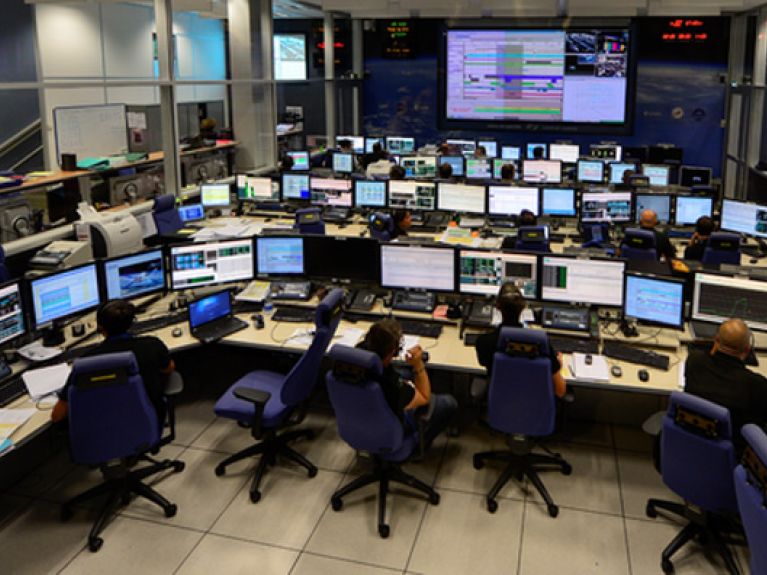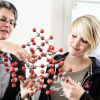Rocketing cooperation
International cooperation instead of bitter rivalry for supremacy in space – ESA has been instrumental in establishing this new approach to spaceflight.

The 6 August 2014 will go down in the history of spaceflight. It was the day on which the European Space Agency (ESA) probe Rosetta reached the orbit of comet 67P/Churyumov-Gerasimenko after a ten-year journey through space. By November 2014 it will have further closed the more than 400-million-kilometre distance between Earth and this celestial body. Then the suspense will grow again: the probe’s lander Philae will attempt a first-ever landing on a comet and take samples from its surface. Those responsible at ESA hope this will provide information on the origins of our solar system and on whether Earth’s water was once brought here from such small celestial bodies. Rosetta is one of ESA’s most ambitious missions.
The European Space Agency also has two other missions in the pipeline that could cause a global sensation: in the course of the next ten years, it plans to put the first Europeans on Mars, with a manned moon landing scheduled prior to this. Both will be missions that are not only controlled from Earth but which will actually put human beings into space.
First of all, though, the spotlight is on Rosetta as Europe marks 50 years of cooperation in space. Thomas Reiter, ESA’s Director of Human Spaceflight and Operations, even compares the mission’s significance to that of the first manned moon landing. The 17 participating nations are spending some 1.3 billion euros on the project, with Germany’s share coming to 300 million euros. That the participating countries share the costs of the space missions has been a basic principle of European space cooperation right from the start. This began in 1964, but it dates back even further – to 1957 when the Russians put the first satellite, Sputnik, into Earth orbit. It was an event that not only alarmed Russia’s major rival, the United States. The Europeans didn’t want to be left out of the space race for good, either.
But one thing was clear to them: individual countries would, on their own, never be able to compete with the Western and Eastern bloc “giants” – especially as many scientists had emigrated to the United States or the Soviet Union after the Second World War.
As is sometimes the case when many partners are involved and have to reach agreement, it took a while for European cooperation in space to become a reality. To be precise: after the first talks in 1958, another six years. Ten European nations sat at the table back then – the founders of European spaceflight. And Germany was one of them. To begin with, two organisations were set up in 1964 with different remits: ELDO was responsible for developing carrier systems and ESRO for scientific satellites. They were the forerunners of what is now ESA, which they merged to form in 1975.
The Europeans’ answer to the rivalry between the two superpowers was to cooperate among themselves – and they were successful. Today, ESA is on an equal footing with the US and Russian space agencies, NASA and Roskosmos. On the whole, the former space race has since given way to cooperation: for years now, European and US astronauts have been working together with Russian cosmonauts aboard the International Space Station (ISS).
“ESA covers the whole spectrum of spaceflight,” says Thomas Reiter, a former astronaut himself. More than 50 missions have been sent into space so far. Their job is to observe our own planet, explore other celestial bodies or simply improve our lives. ESA satellites gather information that is designed to help better assess climate change or provide early warning of natural disasters. Since 2009 Goce has been carrying out gravity measurements, and since 2013 Swarm has been monitoring the Earth’s magnetic field. Other satellites “feed” navigation systems, and the military is another beneficiary of space data. In 2003 Mars Express was sent to the Red Planet, and in 2005 Huygens landed on Saturn’s moon Titan. Gaia was launched in December 2013; its mission: to map one billion stars in our Milky Way. ESA also contributes to the International Space Station: in 2008 its Columbus laboratory was permanently installed as part of the ISS. Its control centre is located on the grounds of the German Aerospace Center in Oberpfaffenhofen near Munich. ESA has also long possessed the capability to put its mis¬sions into orbit using its own Ariane rockets, and it has its own spaceport in Kourou in French Guiana.
All these institutions and missions have their price, of course: ESA has an average annual budget of around 4.2 billion euros, which is supplied by its member states. Germany regularly contributes the largest amount – 772.4 million euros in 2013 – followed by France (747.5 million), Italy (400 million) and the United Kingdom (300 million). That sounds like a lot of money, but those responsible put these figures into perspective: “On average, every citizen of an ESA member state pays, in taxes for expenditure on space, about the same as the price of a cinema ticket,” states ESA’s website, adding that in the United States investment in civilian space activities is almost four times as much. In any case, these investments must be set against the important knowledge and valuable supply of data obtained from space. And last but not least, ESA is also a major economic factor.
In Darmstadt, for example, where the European Space Operations Centre (ESOC) has been located since 1967, a veritable “space quarter” has grown up. Europe’s “gateway to space” exerts a strong attraction: over the years, a number of businesses and organisations that are dependent on spaceflight have been established in the vicinity of the approximately 50,000-square-metre site. One of them is EUMETSAT, an organisation employing a workforce of 400 that operates a European system of meteorological satellites. Other companies that are located there develop technical systems and processes for spaceflight. “We are one of the pacesetters for high-tech industry in the region,” says Alexander Cwielong, Head of Strategy and Controlling at ESOC.
Another major ESA facility is the European Astronaut Centre in Cologne, which selects and trains astronauts for missions. That’s also where Alexander Gerst prepared for his stay on the International Space Station. He is the eleventh German astronaut in space and will return to Earth in November 2014. ▪

